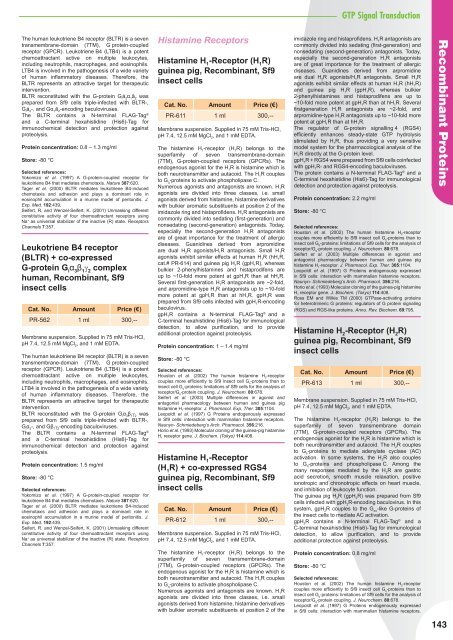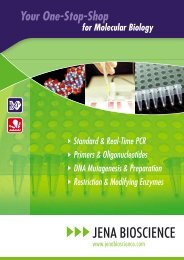Nucleotide Analogs - Jena Bioscience
Nucleotide Analogs - Jena Bioscience
Nucleotide Analogs - Jena Bioscience
You also want an ePaper? Increase the reach of your titles
YUMPU automatically turns print PDFs into web optimized ePapers that Google loves.
The human leukotriene B4 receptor (BLTR) is a seven<br />
transmembrane-domain (7TM), G protein-coupled<br />
receptor (GPCR). Leukotriene B4 (LTB4) is a potent<br />
chemoattractant active on multiple leukocytes,<br />
including neutrophils, macrophages, and eosinophils.<br />
LTB4 is involved in the pathogenesis of a wide variety<br />
of human infl ammatory diseases. Therefore, the<br />
BLTR represents an attractive target for therapeutic<br />
intervention.<br />
BLTR reconstituted with the G-protein G i á 2 α 1 ã 2 was<br />
prepared from Sf9 cells triple-infected with BLTR-,<br />
G iá 2-, and Gα 1ã 2-encoding baculoviruses.<br />
The BLTR contains a N-terminal FLAG-Tag ®<br />
and a C-terminal hexahistidine (His6)-Tag for<br />
immunochemical detection and protection against<br />
proteolysis.<br />
Protein concentration: 0.8 – 1.3 mg/ml<br />
Store: -80 °C<br />
Selected references:<br />
Yokomizo et al. (1997) A G-protein-coupled receptor for<br />
leukotriene B4 that mediates chemotaxis. Nature 387:620.<br />
Tager et al. (2000) BLTR mediates leukotriene B4-induced<br />
chemotaxis and adhesion and plays a dominant role in<br />
eosinophil accumulation in a murine model of peritonitis. J.<br />
Exp. Med. 192:439.<br />
Seifert, R. and Wenzel-Seifert, K. (2001) Unmasking different<br />
constitutive activity of four chemoattractant receptors using<br />
Na + as universal stabilizer of the inactive (R) state. Receptors<br />
Channels 7:357.<br />
Leukotriene B4 receptor<br />
(BLTR) + co-expressed<br />
G-protein G i α 3 β 1 γ 2 complex<br />
human, Recombinant, Sf9<br />
insect cells<br />
Cat. No. Amount Price (€)<br />
PR-562 1 ml 300,--<br />
Membrane suspension. Supplied in 75 mM Tris-HCl,<br />
pH 7.4, 12.5 mM MgCl 2 , and 1 mM EDTA.<br />
The human leukotriene B4 receptor (BLTR) is a seven<br />
transmembrane-domain (7TM), G protein-coupled<br />
receptor (GPCR). Leukotriene B4 (LTB4) is a potent<br />
chemoattractant active on multiple leukocytes,<br />
including neutrophils, macrophages, and eosinophils.<br />
LTB4 is involved in the pathogenesis of a wide variety<br />
of human infl ammatory diseases. Therefore, the<br />
BLTR represents an attractive target for therapeutic<br />
intervention.<br />
BLTR reconstituted with the G-protein G iα 3β 1γ 2 was<br />
prepared from Sf9 cells triple-infected with BLTR-,<br />
G iα 3-, and Gβ 1γ 2-encoding baculoviruses.<br />
The BLTR contains a N-terminal FLAG-Tag ®<br />
and a C-terminal hexahistidine (His6)-Tag for<br />
immunochemical detection and protection against<br />
proteolysis.<br />
Protein concentration: 1.5 mg/ml<br />
Store: -80 °C<br />
Selected references:<br />
Yokomizo et al. (1997) A G-protein-coupled receptor for<br />
leukotriene B4 that mediates chemotaxis. Nature 387:620.<br />
Tager et al. (2000) BLTR mediates leukotriene B4-induced<br />
chemotaxis and adhesion and plays a dominant role in<br />
eosinophil accumulation in a murine model of peritonitis. J.<br />
Exp. Med. 192:439.<br />
Seifert, R. and Wenzel-Seifert, K. (2001) Unmasking different<br />
constitutive activity of four chemoattractant receptors using<br />
Na + as universal stabilizer of the inactive (R) state. Receptors<br />
Channels 7:357.<br />
Histamine Receptors<br />
Histamine H 1 -Receptor (H 1 R)<br />
guinea pig, Recombinant, Sf9<br />
insect cells<br />
Cat. No. Amount Price (€)<br />
PR-611 1 ml 300,--<br />
Membrane suspension. Supplied in 75 mM Tris-HCl,<br />
pH 7.4, 12.5 mM MgCl 2 , and 1 mM EDTA.<br />
The histamine H 1-receptor (H 1R) belongs to the<br />
superfamily of seven transmembrane-domain<br />
(7TM), G-protein-coupled receptors (GPCRs). The<br />
endogenous agonist for the H 1 R is histamine which is<br />
both neurotransmitter and autacoid. The H 1R couples<br />
to G q-proteins to activate phospholipase C.<br />
Numerous agonists and antagonists are known. H 1 R<br />
agonists are divided into three classes, i.e. small<br />
agonists derived from histamine, histamine derivatives<br />
with bulkier aromatic substituents at position 2 of the<br />
imidazole ring and histaprofi dens. H 1R antagonists are<br />
commonly divided into sedating (fi rst-generation) and<br />
nonsedating (second-generation) antagonists. Today,<br />
especially the second-generation H 1 R antagonists<br />
are of great importance for the treatment of allergic<br />
diseases. Guanidines derived from arpromidine<br />
are dual H 2 R agonists/H 1 R antagonists. Small H 1 R<br />
agonists exhibit similar effects at human H 1 R (hH 1 R,<br />
cat.# PR-614) and guinea pig H 1 R (gpH 1 R), whereas<br />
bulkier 2-phenylhistamines and histaprodifens are<br />
up to ~10-fold more potent at gpH 1 R than at hH 1 R.<br />
Several fi rst-generation H 1 R antagonists are ~2-fold,<br />
and arpromidine-type H 1 R antagonists up to ~10-fold<br />
more potent at gpH 1 R than at hH 1 R. gpH 1 R was<br />
prepared from Sf9 cells infected with gpH 1 R-encoding<br />
baculovirus.<br />
gpH 1 R contains a N-terminal FLAG-Tag ® and a<br />
C-terminal hexahistidine (His6)-Tag for immunological<br />
detection, to allow purifi cation, and to provide<br />
additional protection against proteolysis.<br />
Protein concentration: 1 – 1.4 mg/ml<br />
Store: -80 °C<br />
Selected references:<br />
Houston et al. (2002) The human histamine H 2 -receptor<br />
couples more effi ciently to Sf9 insect cell G s -proteins than to<br />
insect cell G q -proteins: limitations of Sf9 cells for the analysis of<br />
receptor/G q -protein coupling. J. Neurochem. 80:678.<br />
Seifert et al. (2003) Multiple differences in agonist and<br />
antagonist pharmacology between human and guinea pig<br />
histamine H 1 -receptor. J. Pharmacol. Exp. Ther. 305:1104.<br />
Leopoldt et al. (1997) G Proteins endogenously expressed<br />
in Sf9 cells: interaction with mammalian histamine receptors.<br />
Naunyn- Schmiedeberg’s Arch. Pharmacol. 356:216.<br />
Horio et al. (1993) Molecular cloning of the guinea-pig histamine<br />
H 1 receptor gene. J. Biochem. (Tokyo) 114:408.<br />
Histamine H 1 -Receptor<br />
(H 1 R) + co-expressed RGS4<br />
guinea pig, Recombinant, Sf9<br />
insect cells<br />
Cat. No. Amount Price (€)<br />
PR-612 1 ml 300,--<br />
Membrane suspension. Supplied in 75 mM Tris-HCl,<br />
pH 7.4, 12.5 mM MgCl 2 , and 1 mM EDTA.<br />
The histamine H 1 -receptor (H 1 R) belongs to the<br />
superfamily of seven transmembrane-domain<br />
(7TM), G-protein-coupled receptors (GPCRs). The<br />
endogenous agonist for the H 1 R is histamine which is<br />
both neurotransmitter and autacoid. The H 1 R couples<br />
to G q -proteins to activate phospholipase C.<br />
Numerous agonists and antagonists are known. H 1 R<br />
agonists are divided into three classes, i.e. small<br />
agonists derived from histamine, histamine derivatives<br />
with bulkier aromatic substituents at position 2 of the<br />
GTP Signal Transduction<br />
imidazole ring and histaprofi dens. H 1 R antagonists are<br />
commonly divided into sedating (fi rst-generation) and<br />
nonsedating (second-generation) antagonists. Today,<br />
especially the second-generation H 1 R antagonists<br />
are of great importance for the treatment of allergic<br />
diseases. Guanidines derived from arpromidine<br />
are dual H 2 R agonists/H 1 R antagonists. Small H 1 R<br />
agonists exhibit similar effects at human H 1 R (hH 1 R)<br />
and guinea pig H 1 R (gpH 1 R), whereas bulkier<br />
2-phenylhistamines and histaprodifens are up to<br />
~10-fold more potent at gpH 1 R than at hH 1 R. Several<br />
fi rstgeneration H 1R antagonists are ~2-fold, and<br />
arpromidine-type H 1 R antagonists up to ~10-fold more<br />
potent at gpH 1 R than at hH 1 R.<br />
The regulator of G-protein signalling 4 (RGS4)<br />
effi ciently enhances steady-state GTP hydrolysis<br />
stimulated by H 1 R, thus providing a very sensitive<br />
model system for the pharmacological analysis of the<br />
H 1 R directly at the G-protein level.<br />
gpH 1 R + RGS4 were prepared from Sf9 cells coinfected<br />
with gpH 1 R- and RGS4-encoding baculoviruses.<br />
The protein contains a N-terminal FLAG-Tag ® and a<br />
C-terminal hexahistidine (His6)-Tag for immunological<br />
detection and protection against proteolysis.<br />
Protein concentration: 2.2 mg/ml<br />
Store: -80 °C<br />
Selected references:<br />
Houston et al. (2002) The human histamine H 2 -receptor<br />
couples more effi ciently to Sf9 insect cell G s -proteins than to<br />
insect cell G q -proteins: limitations of Sf9 cells for the analysis of<br />
receptor/G q -protein coupling. J. Neurochem. 80:678.<br />
Seifert et al. (2003) Multiple differences in agonist and<br />
antagonist pharmacology between human and guinea pig<br />
histamine H 1 -receptor. J. Pharmacol. Exp. Ther. 305:1104.<br />
Leopoldt et al. (1997) G Proteins endogenously expressed<br />
in Sf9 cells: interaction with mammalian histamine receptors.<br />
Naunyn- Schmiedeberg’s Arch. Pharmacol. 356:216.<br />
Horio et al. (1993) Molecular cloning of the guinea-pig histamine<br />
H 1 receptor gene. J. Biochem. (Tokyo) 114:408.<br />
Ross EM and Wilkie TM (2000) GTPase-activating proteins<br />
for heterotrimeric G proteins: regulators of G protein signaling<br />
(RGS) and RGS-like proteins. Annu. Rev. Biochem. 69:795.<br />
Histamine H 2-Receptor (H 2R)<br />
guinea pig, Recombinant, Sf9<br />
insect cells<br />
Cat. No. Amount Price (€)<br />
PR-613 1 ml 300,--<br />
Membrane suspension. Supplied in 75 mM Tris-HCl,<br />
pH 7.4, 12.5 mM MgCl 2, and 1 mM EDTA.<br />
The histamine H 2-receptor (H 2R) belongs to the<br />
superfamily of seven transmembrane domain<br />
(7TM), G-protein-coupled receptors (GPCRs). The<br />
endogenous agonist for the H 2R is histamine which is<br />
both neurotransmitter and autacoid. The H 2 R couples<br />
to G s -proteins to mediate adenylate cyclase (AC)<br />
activation. In some systems, the H 2 R also couples<br />
to G q -proteins and phospholipase C. Among the<br />
many responses mediated by the H 2 R are gastric<br />
acid secretion, smooth muscle relaxation, positive<br />
ionotropic and chronotropic effects on heart muscle,<br />
and inhibition of leukocyte function.<br />
The guinea pig H 2 R (gpH 2 R) was prepared from Sf9<br />
cells infected with gpH 2 R-encoding baculovirus. In this<br />
system, gpH 2 R couples to the G sα -like G-proteins of<br />
the insect cells to mediate AC activation.<br />
gpH 2 R contains a N-terminal FLAG-Tag ® and a<br />
C-terminal hexahistidine (His6)-Tag for immunological<br />
detection, to allow purifi cation, and to provide<br />
additional protection against proteolysis.<br />
Protein concentration: 0.8 mg/ml<br />
Store: -80 °C<br />
Selected references:<br />
Houston et al. (2002) The human histamine H 2 -receptor<br />
couples more effi ciently to Sf9 insect cell G s -proteins than to<br />
insect cell G q -proteins: limitations of Sf9 cells for the analysis of<br />
receptor/G q -protein coupling. J. Neurochem. 80:678.<br />
Leopoldt et al. (1997) G Proteins endogenously expressed<br />
in Sf9 cells: interaction with mammalian histamine receptors.<br />
Recombinant Proteins<br />
143



